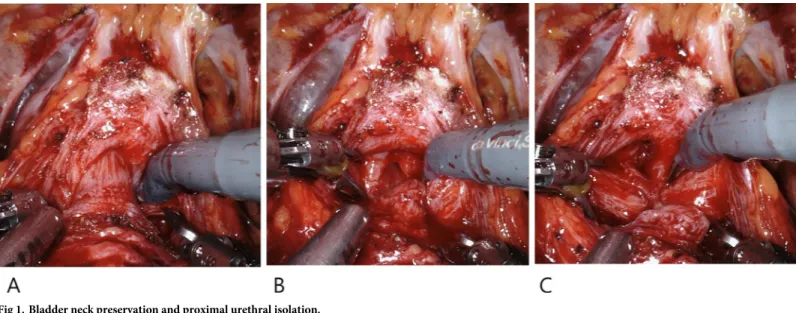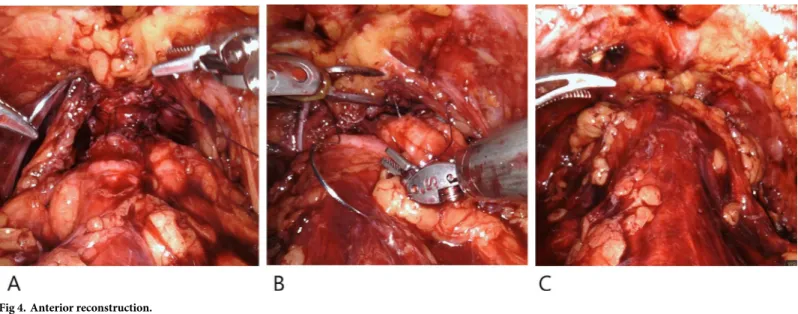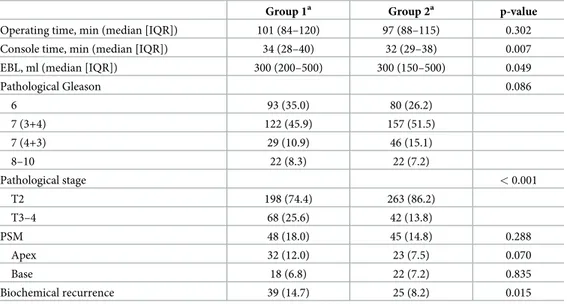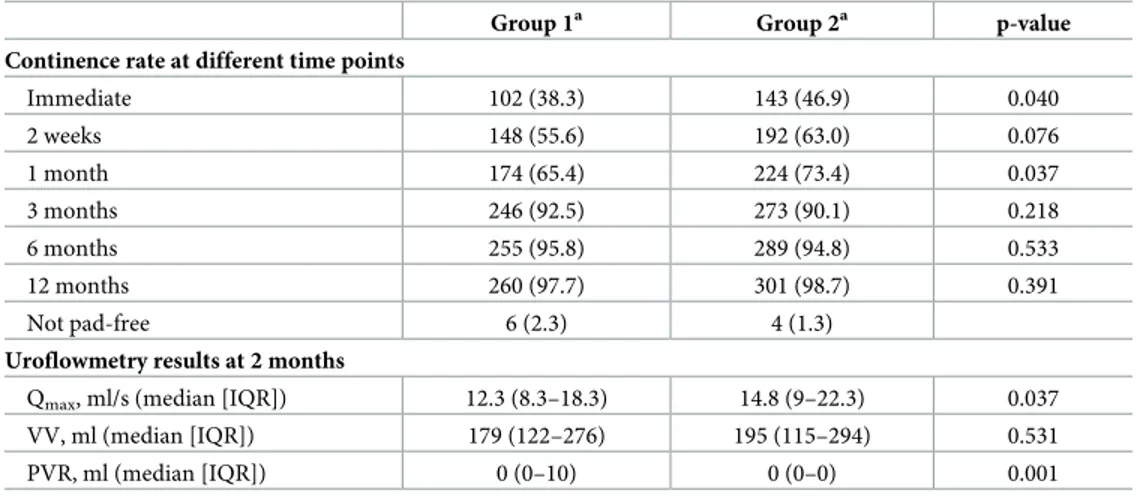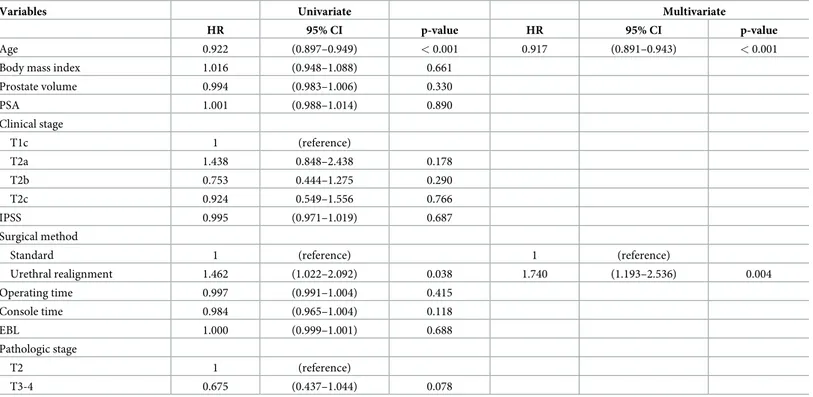Urethral realignment with maximal urethral
length and bladder neck preservation in
robot-assisted radical prostatectomy: Urinary
continence recovery
Ji Eun Heo1, Jong Soo Lee1, Hyeok Jun Goh2, Won Sik Jang1, Young Deuk ChoiID1*
1 Department of Urology and Urological Science Institute, Yonsei University College of Medicine, Seoul,
Republic of Korea, 2 Department of Urology, Dong-A University College of Medicine, Busan, Republic of Korea
*youngd74@yuhs.ac
Abstract
Purpose
To evaluate early recovery of urinary continence after robot-assisted radical prostatectomy (RARP) with urethral realignment using bladder neck preservation (BNP) and maximal ure-thral length preservation (MULP).
Methods
Patients who underwent RARP between 2014 and 2017 owing to prostate cancer with a Gleason score�7 (3+4),�cT2c stage, and prostate-specific antigen level<20 ng/ml were investigated. Patients with tumors of the bladder neck or apex on magnetic resonance imag-ing were excluded. A total of 266 patients underwent the operation usimag-ing the standard method between 2014 and 2015 (group 1), while 305 patients underwent urethral realign-ment between 2016 and 2017 (group 2). Continence was defined as wearing no pad or one security pad.
Results
The continence rates immediately after Foley catheter removal, at 2 weeks, and at 1, 3, 6, and 12 months after operation in group 2 were 46.9%, 63.0%, 73.4%, 90.1%, 94.8%, and 98.7%, respectively. The continence rate at 1 month in group 2 was significantly higher than that in group 1 (65.4% versus 73.4%, p = 0.037). The multivariate regression analysis showed that age and surgical method were factors affecting early continence recovery. The positive surgical margin rates were 18.0% and 14.8% in groups 1 and 2, respectively (p = 0.288). Biochemical recurrence occurred in 14.7% and 8.2% in groups 1 and 2, respectively (p = 0.015). a1111111111 a1111111111 a1111111111 a1111111111 a1111111111 OPEN ACCESS
Citation: Heo JE, Lee JS, Goh HJ, Jang WS, Choi YD (2020) Urethral realignment with maximal urethral length and bladder neck preservation in robot-assisted radical prostatectomy: Urinary continence recovery. PLoS ONE 15(1): e0227744.
https://doi.org/10.1371/journal.pone.0227744
Editor: Peter F.W.M. Rosier, University Medical Center Utrecht, NETHERLANDS
Received: September 16, 2019 Accepted: December 27, 2019 Published: January 13, 2020
Copyright:© 2020 Heo et al. This is an open access article distributed under the terms of the
Creative Commons Attribution License, which permits unrestricted use, distribution, and reproduction in any medium, provided the original author and source are credited.
Data Availability Statement: Data are restricted due to patients’ privacy and research ethics by the Severance Hospital and Yonsei University College of Medicine Data Access and Ethics Committee. The release of patient data to the public would be a violation of IRB terms of approval (IRB number: 4-2019-0106). Qualifying researchers may apply for data access with Yonsei University College Institutional Review Board atirb@yuhs.ac. Funding: The authors received no specific funding for this work.
Conclusion
Urethral realignment using BNP and MULP resulted in rapid continence recovery and good oncological results after RARP in young patients with a Gleason score�7 and organ-con-fined disease.
Introduction
Robot-assisted radical prostatectomy (RARP) is one of the standard surgical treatments for clinical localized prostate cancer (PCa). Optimal cancer control is the primary goal of RARP; nevertheless, RARP also aims to preserve urinary continence. Robotic technology enables sur-geons to execute precise movements for the preservation of anatomical structures essential for urinary continence and potency. In a previous systematic review and meta-analysis of urinary continence after RARP, the 12-month urinary incontinence rates ranged from 8% to 11% (mean, 9%) among the included studies that defined continence as wearing no pad or safety pad [1].
Urinary incontinence may have a serious negative effect on the quality of life among patients undergoing radical prostatectomy (RP) [1]. Although the complicated physiology of mechanisms related to urinary continence after RP remains unclear, bladder neck preservation (BNP) is considered to play the most important role [2–4]. However, the extent of BNP should be considered because aggressive BNP could be associated with higher positive surgical margin (PSM) rate, particularly for non-organ-confined cancers [5,6]. With respect to both optimal cancer control and urinary continence, maximal BNP is a reasonable surgical technique for patients with clinically organ-confined cancer and Gleason score (GS) � 7 (3+4).
Maximal urethral length preservation (MULP) has been shown to ensure early return of continence [7–9]. Increased urethral length, which includes a greater number of smooth mus-cle fibers and rhabdosphincters, aids in the functional recovery of the rhabdosphincter [10]. Thus, a combination of BNP and MULP techniques to attain urethral realignment may maxi-mize the functional urethral length and achieve early recovery of urinary continence.
The present study aimed to evaluate recovery of urinary continence after RARP with ure-thral realignment using BNP and MULP techniques compared with that using the standard technique of RARP. The primary endpoint was to assess the urinary continence rate at differ-ent time points, whereas the secondary endpoint was to examine oncological outcomes.
Materials and methods
This study was approved by the institutional review board (IRB) of Yonsei University Sever-ance Hospital (IRB number: 4-2019-0106) and the requirement for informed consent was waived. The patient records and information were anonymized prior to analysis. Data were retrospectively collected from patients who underwent RARP for PCa at our institution from January 2014 to December 2017. Multiparametric magnetic resonance imaging (MRI) of the prostate was performed in all cases. Patients with localized PCa (clinical stages T1–T2cN0M0), GS � 7 (3+4), and prostate-specific antigen (PSA) level < 20 ng/ml were investigated [11]. For patients whose tumors were suspected to be located on the bladder neck or apex on MRI, the urethral realignment technique was not performed. The standard technique of RARP was per-formed in cases treated between 2014 and 2015 (group 1; n = 266), that patients with tumors of the bladder neck or apex on MRI also excluded. Patients treated between 2016 and 2017
Competing interests: The authors have declared that no competing interests exist.
underwent the surgeries with urethral realignment technique using BNP and MULP tech-niques (group 2; n = 305). A single surgeon (Y.D.C.) with experience of performing more than 3,000 RARPs performed all surgeries. Planned procedures were discussed with each patient, from whom informed consent was obtained. Preoperative functional parameters were assessed using the International Prostate Symptom Score questionnaires.
The technique of BNP in RARP has been previously described [12]. In brief, the anterior bladder is tented by traction of the cephalad part of the detrusor muscle to form a ridge at the detrusor apron. Using a combination of sharp and blunt dissection to tease bladder muscle fibers away from the prostate, a funneling bladder neck is created. After dissecting anteriorly and circumferentially, the anterior side of the bladder neck are incised as distally as possible. The procedure of MULP in RARP was described by Hamada et al [10]. In brief, after dis-secting the dorsal vein complex, the apex and the rhabdosphincter are seen. Toward the mem-branous urethra, the striated and smooth muscle fibers are carefully divided. By releasing the fibrous connections of the prostate at the apex, an additional length of the intra-abdominal urethra is obtained.
Our surgeries were performed using the extraperitoneal approach [13]. The endopelvic fas-cia was minimally dissected. The BNP technique employed was similar to that previously described [12]. With incision of the detrusor muscle fibers at the insertion on the ventral sur-face of the prostate base, athermal dissection was continued until the longitudinal smooth muscle component of the urethra was identified. Subsequently, the bladder neck was pulled cephalad, and the proximal urethra was isolated. The isolated urethra was incised just below the verumontanum. After the dorsal side of the prostate base was dissected from the bladder neck using cold scissors, the bladder neck and proximal urethra were completely preserved, and the intraoperative urethral length measured as approximately 10 mm (Fig 1).
The seminal vesicles were dissected from Denonvilliers’ fascia. The dorsal surface of the prostate was bluntly dissected toward the apex, with the seminal vesicles being pulled. The detrusor apron that covered the anterior surface of the prostate was incised, whereas the pubo-prostatic ligaments were preserved, and the dorsal vein was not ligated. The prostate was pulled cephalad, and the prostatic apex was released from the fibrous and muscular connective tissues around the urethra [10]. The distal urethra was maximally isolated and incised just
Fig 1. Bladder neck preservation and proximal urethral isolation.
below the prostatic apex using cold scissors. The lateral surface of the prostate was dissected with minimal electrocauterization, and the pelvic floor tissue was preserved. (Fig 2).
Neurovascular bundle preservation was routinely accomplished, and pelvic lymph node dissection was not performed in this cohort.
The proximal and distal urethra was anastomosed using continuous 3–0 monofilament suture (Fig 3).
After urethral realignment, anterior reconstruction was completed by reattaching the pubo-prostatic ligaments and the deep dorsal vein complex to the anterior distal bladder [14]. The
Fig 2. Preservation of maximal distal urethral length and pelvic floor tissue.
https://doi.org/10.1371/journal.pone.0227744.g002
Fig 3. Urethral realignment.
dissected space around the bladder was closed by suturing the anterior bladder to the arcus tendineus. Anterior reconstruction was also performed using the standard technique. Anasto-motic integrity was routinely checked by distending the bladder using 150 ml of saline to con-firm the absence of visible leakage (Fig 4).
The extraperitoneal drainage was removed. The patients were discharged on the 2nd post-operative day, whereas the catheter was removed on the 10thpostoperative day. All patients were instructed to perform pelvic floor muscle exercises, which were initiated from the time of catheter removal until continence recovery. The continence rate was regularly assessed by patient reporting immediately after Foley catheter removal, at 2 weeks, and at 1, 3, 6, and 12 months. Continence was defined as wearing no pad or one pad for security or occasional stress incontinence that patients self-reported. Uroflowmetry was performed at the 2-month follow-up to evaluate voiding patterns, and MRI was simultaneously performed.
Biochemical recurrence (BCR) was defined as detectable PSA after RP or any two consecu-tive increases of � 0.2 ng/ml in PSA level with undetectable PSA after RP [15].
Continuous variables are expressed as medians (interquartile ranges), whereas categorical variables are reported as number of occurrences and frequency. Student’st-test was used to
compare continuous variables, whereas chi-square test was used to compare categorical vari-ables. Parameters were estimated in univariate and multivariate logistic regression analyses to identify predictors of early continence recovery. Statistical analysis was performed using SPSS version 23.0 (IBM Corp., Armonk, NY, USA). A p-value (p) < 0.05 was considered to indicate statistical significance.
Results
A total of 571 patients were included in this study. The patient characteristics are summarized inTable 1. There was a significant difference between the ages of the patients in the groups, with median values of 65 years and 66 years for groups 1 and 2, respectively (p = 0.014). The median prostate volume measured by transrectal ultrasonography was 30 g in group 1 and 31 g in group 2 (p = 0.165). Patients with a biopsy GS 6 were 66.5% and 58.4% for groups 1 and 2, respectively (p = 0.047). No significant differences in body mass index, PSA level, clinical
Fig 4. Anterior reconstruction.
stage, and baseline urinary function were observed between the two groups (p = 0.120, 0.165, 0.375 and 0.928, respectively).
The median operating times were 101 min and 97 min in groups 1 and 2, respectively (p = 0.302). The median console times were 34 min in group 1 and 32 min in group 2 (p = 0.007). The median value of estimated blood loss was 300 cc in both groups (Table 2).
Table 1. Patients’ characteristics.
Group 1a Group 2a p-value
No. of patients 266 305
Age, years (median [IQR]) 65 (59–69) 66 (61–71) 0.014
Body mass index, kg/m2(median [IQR]) 24.16 (22.15–25.47) 24.22 (23.18–25.82) 0.120 Prostate volume, g (median [IQR]) 30 (25–40) 31 (26–42) 0.165 PSA, ng/ml (median [IQR]) 6.67 (4.79–10.20) 6.47 (4.86–9.92) 0.893
Biopsy Gleason score 0.047
6 177 (66.5) 178 (58.4) 7 (3+4) 89 (33.5) 127 (41.6) Clinical stage 0.375 T1c 63 (23.7) 55 (18.0) T2a 77 (28.9) 94 (30.8) T2b 57 (21.4) 76 (24.9) T2c 69 (25.9) 80 (26.2)
IPSS (median [IQR]) 15 (9–20) 14 (9–19) 0.928
aGroup 1: Standard method, Group 2: Urethral realignment method
Data are expressed as N (%) unless otherwise specified.
IPSS, International Prostate Symptom Score; IQR, interquartile range; PSA, prostate-specific antigen.
https://doi.org/10.1371/journal.pone.0227744.t001
Table 2. Intraoperative variables, pathological data, and biochemical recurrence.
Group 1a Group 2a p-value
Operating time, min (median [IQR]) 101 (84–120) 97 (88–115) 0.302 Console time, min (median [IQR]) 34 (28–40) 32 (29–38) 0.007 EBL, ml (median [IQR]) 300 (200–500) 300 (150–500) 0.049
Pathological Gleason 0.086 6 93 (35.0) 80 (26.2) 7 (3+4) 122 (45.9) 157 (51.5) 7 (4+3) 29 (10.9) 46 (15.1) 8–10 22 (8.3) 22 (7.2) Pathological stage < 0.001 T2 198 (74.4) 263 (86.2) T3–4 68 (25.6) 42 (13.8) PSM 48 (18.0) 45 (14.8) 0.288 Apex 32 (12.0) 23 (7.5) 0.070 Base 18 (6.8) 22 (7.2) 0.835 Biochemical recurrence 39 (14.7) 25 (8.2) 0.015 a
Group 1: Standard method, Group 2: Urethral realignment method Data are expressed as N (%) unless otherwise specified.
EBL, estimated blood loss; IQR, interquartile range; PSM, positive surgical margin.
The pathological results are presented inTable 2. The rates of pathological GS � 7 (4+3) were not different between the two groups (19.2% vs. 22.3%, p = 0.086). The rates of pathologi-cal stage � T3a were 25.6% in group 1 and 13.8% in group 2 (p < 0.001). The overall PSM rates were 18.0% and 14.8% in groups 1 and 2, respectively. The PSM rates according to loca-tion in group 2 were 7.5% at the apex and 7.2% at the base, with the PSM rates not significantly different from those in group 1 (apex; p = 0.070, base; p = 0.835). BCR occurred in 39 (14.7%) of patients from group 1 and in 25 (8.2%) from group 2. The difference in BCR rates between both groups was statistically significant (p = 0.015). Local recurrence was not detected in the follow-up image study.
The continence rates at immediate follow-up were 38.3% and 46.9% for groups 1 and 2, respectively (p = 0.040). The continence rates gradually improved at 2 weeks, and 1, 3, 6, and 12 months in both groups (group 1: 55.6%, 65.4%, 92.5%, 95.8%, 97.7%; group 2: 63.0%, 73.4%, 90.1%, 94.8%, 98.7%, respectively). The continence rates at 1 month were significantly higher in group 2 than in group 1 (p = 0.037). According to the previously described definition of urinary continence, 6 patients in group 1 and 4 in group 2 still used more than one pad per day at the 12-month follow-up (Table 3). One patient in group 1 underwent insertion of an artificial urethral sphincter.
Uroflowmetry results are shown inTable 3. The median maximum urinary flow rate (Qmax) was 12.3 ml/s in group 1 and 14.8 ml/s in group 2. The median voided volume was 179
ml in group 1 and 195 ml in group 2. The median post-void residual volume was 0 ml in both groups.
Univariate regression analysis revealed that age (hazard ratio [HR] = 0.922 [95% confidence interval 0.897–0.949], p < 0.001) and surgical method (HR = 1.462 [1.022–2.092], p = 0.038) were predictors of continence at 1 month after surgery. Both variables were significant predic-tors in multivariate regression analysis (age: HR = 0.917 [0.891–0.943], p < 0.001; surgical method: HR = 1.740 [1.193–2.536], p = 0.004;Table 4).
Discussion
Considering the negative effect of urinary incontinence after RP on patients’ quality of life, uri-nary continence recovery after RP is increasingly considered to be as important as cancer
Table 3. Continence rates and uroflowmetry results.
Group 1a Group 2a p-value
Continence rate at different time points
Immediate 102 (38.3) 143 (46.9) 0.040 2 weeks 148 (55.6) 192 (63.0) 0.076 1 month 174 (65.4) 224 (73.4) 0.037 3 months 246 (92.5) 273 (90.1) 0.218 6 months 255 (95.8) 289 (94.8) 0.533 12 months 260 (97.7) 301 (98.7) 0.391 Not pad-free 6 (2.3) 4 (1.3)
Uroflowmetry results at 2 months
Qmax, ml/s (median [IQR]) 12.3 (8.3–18.3) 14.8 (9–22.3) 0.037
VV, ml (median [IQR]) 179 (122–276) 195 (115–294) 0.531
PVR, ml (median [IQR]) 0 (0–10) 0 (0–0) 0.001
aGroup 1: Standard method, Group 2: Urethral realignment method
Data are expressed as N (%) unless otherwise specified.
PVR, post-void residual volume; Qmax, maximum urinary flow rate; VV, voided volume.
control [16]. Accurate robot-assisted surgery is available to minimize postoperative complica-tions and preserve the anatomical structures associated with urinary incontinence. Thus, RARP can achieve improved results in continence recovery compared to the open or laparo-scopic approach [1]. The complex mechanism of recovery from urethral symptoms after RP is not yet fully understood; nonetheless, it is widely accepted that surgeons should preserve the bladder neck, rhabdosphincter, and periurethral supporting structures, and perform nerve-sparing surgery and reconstruction. Several surgical procedures have been proposed for this purpose [9,10,14,17–21].
Various mechanisms have been considered responsible for continence after RP, and BNP appears to play the most important role [2–4]. The significance of bladder neck for continence was shown in a study on cases of traumatic posterior urethral injury [22]. MULP can preserve the rhabdosphincter, which is located between the verumontanum and the distal edge of the prostatic apex. Hamada et al. [10] reported a continence rate of 70% for MULP at 1 month after surgery. By leaving the urethral stump longer, vesicourethral anastomosis can be facili-tated, and bladder descent can be reduced. In our study, this advantage can be further maxi-mized through BNP, and urethral realignment can be achieved using combined BNP and MULP techniques. Moreover, anterior reconstruction provides anatomical support for the sta-bilization of the urethra and rhabdosphincter in their anatomical position [17]. Hence, we per-formed anterior reconstruction for all the patients.
In a systematic review and meta-analysis of continence recovery after RARP, the 12-month continence rates ranged from 89% to 92% among studies that used “no pad or safety pad” as the definition of continence. In addition, studies involving approximately 100 cases reported 1-month continence rates of 33–86% [1]. In our study, continence rates at immediate follow-up and at 1 month in grofollow-up 2 were significantly higher than those in grofollow-up 1. Continence
Table 4. Univariate and multivariate regression analysis of continence at 1 month.
Variables Univariate Multivariate
HR 95% CI p-value HR 95% CI p-value
Age 0.922 (0.897–0.949) < 0.001 0.917 (0.891–0.943) < 0.001
Body mass index 1.016 (0.948–1.088) 0.661
Prostate volume 0.994 (0.983–1.006) 0.330 PSA 1.001 (0.988–1.014) 0.890 Clinical stage T1c 1 (reference) T2a 1.438 0.848–2.438 0.178 T2b 0.753 0.444–1.275 0.290 T2c 0.924 0.549–1.556 0.766 IPSS 0.995 (0.971–1.019) 0.687 Surgical method
Standard 1 (reference) 1 (reference)
Urethral realignment 1.462 (1.022–2.092) 0.038 1.740 (1.193–2.536) 0.004 Operating time 0.997 (0.991–1.004) 0.415 Console time 0.984 (0.965–1.004) 0.118 EBL 1.000 (0.999–1.001) 0.688 Pathologic stage T2 1 (reference) T3-4 0.675 (0.437–1.044) 0.078
CI, confidence interval; EBL, estimated blood loss; HR, hazard ratio; IPSS, International Prostate Symptom Score; PSA, prostate-specific antigen.
rates at 12 months showed no significant difference between the two groups; nonetheless the continence rates in group 2 were higher than those in group 1. Thus, continence rates within 1 month during the early period improved in patients treated using the urethral realignment technique.
Notably, this technique is not always feasible because of the higher risk of PSM. Patients with tumors located on the bladder neck or apex on MRI or with suspected extraprostatic extension should be excluded. Preoperative selection of patients using MRI ensures that the overall PSM rate is comparable to that in previously published results [13,21]. In addition, the PSM and BCR rates in group 2 were not different from those in group 1, and local recurrence was not observed. Furthermore, despite the significant difference in the pathological stage of the two group, clinical and pathological stages were not significant predictors for early conti-nence recovery. Thus, the urethral realignment technique showed satisfactory oncological out-comes compared with that in the standard technique.
One urethral stricture was recorded in the urethral realignment method; albeit, this compli-cation was successfully resolved after two sessions of urethral dilation. Considering the total number of patients included in the study, urethral realignment and reconstruction of the peri-urethral structures ensured a water-tight anastomosis without increasing the risk for strictures in almost all cases.
The present study has several limitations. First, the sample selection was not randomized, and the majority of patients are classified as low risk [11]. Available treatment plans were dis-cussed with the patients, and men who decided to undergo the operations were investigated. Second, the prostate volume was small; however, these volumes were comparable to those in previous studies on Korean men [23,24]. Finally, the presence of comorbidities that could potentially affect continence status was not recorded in our database. Notwithstanding these study limitations, our study showed promising results with respect to early continence recov-ery in patients after RARP using urethral realignment with combined BNP and MULP techniques.
Conclusion
Urethral realignment with combined BNP and MULP techniques resulted in rapid continence recovery after RARP compared to the standard method. These results were possible owing to the preservation of the anatomical and full functional lengths of both internal and external uri-nary sphincters. The use of our technique in young patients with GS � 7 and organ-confined PCa led to early recovery and produced good oncological results. However, high-risk patients or those with suspected tumors located on the bladder neck or apex on MRI should not be treated using this technique.
Author Contributions
Conceptualization: Ji Eun Heo.
Data curation: Ji Eun Heo, Jong Soo Lee, Hyeok Jun Goh. Formal analysis: Ji Eun Heo.
Investigation: Ji Eun Heo, Jong Soo Lee, Hyeok Jun Goh. Methodology: Jong Soo Lee, Won Sik Jang.
Project administration: Young Deuk Choi.
Supervision: Young Deuk Choi. Writing – original draft: Ji Eun Heo.
Writing – review & editing: Won Sik Jang, Young Deuk Choi.
References
1. Ficarra V, Novara G, Rosen RC, Artibani W, Carroll PR, Costello A, et al. Systematic review and meta-analysis of studies reporting urinary continence recovery after robot-assisted radical prostatectomy. Eur Urol. 2012; 62(3):405–17. Epub 2012/07/04.https://doi.org/10.1016/j.eururo.2012.05.045PMID:
22749852.
2. Selli C, De Antoni P, Moro U, Macchiarella A, Giannarini G, Crisci A. Role of bladder neck preservation in urinary continence following radical retropubic prostatectomy. Scand J Urol Nephrol. 2004; 38(1):32– 7. Epub 2004/06/19.https://doi.org/10.1080/00365590310017280PMID:15204424.
3. Stolzenburg JU, Kallidonis P, Hicks J, Do M, Dietel A, Sakellaropoulos G, et al. Effect of bladder neck preservation during endoscopic extraperitoneal radical prostatectomy on urinary continence. Urol Int. 2010; 85(2):135–8. Epub 2010/05/13.https://doi.org/10.1159/000314842PMID:20460882.
4. Nyarangi-Dix JN, Radtke JP, Hadaschik B, Pahernik S, Hohenfellner M. Impact of complete bladder neck preservation on urinary continence, quality of life and surgical margins after radical prostatectomy: a randomized, controlled, single blind trial. J Urol. 2013; 189(3):891–8. Epub 2012/09/29.https://doi. org/10.1016/j.juro.2012.09.082PMID:23017512.
5. Marcovich R, Wojno KJ, Wei JT, Rubin MA, Montie JE, Sanda MG. Bladder neck-sparing modification of radical prostatectomy adversely affects surgical margins in pathologic T3a prostate cancer. Urology. 2000; 55(6):904–8. Epub 2000/06/07.https://doi.org/10.1016/s0090-4295(00)00451-9PMID:
10840106.
6. Katz R, Salomon L, Hoznek A, de la Taille A, Antiphon P, Abbou CC. Positive surgical margins in laparo-scopic radical prostatectomy: the impact of apical dissection, bladder neck remodeling and nerve pres-ervation. J Urol. 2003; 169(6):2049–52. Epub 2003/05/29.https://doi.org/10.1097/01.ju.0000065822. 15012.b7PMID:12771716.
7. Nguyen L, Jhaveri J, Tewari A. Surgical technique to overcome anatomical shortcoming: balancing post-prostatectomy continence outcomes of urethral sphincter lengths on preoperative magnetic reso-nance imaging. J Urol. 2008; 179(5):1907–11. Epub 2008/03/21.https://doi.org/10.1016/j.juro.2008.01. 036PMID:18353395.
8. Paparel P, Akin O, Sandhu JS, Otero JR, Serio AM, Scardino PT, et al. Recovery of urinary continence after radical prostatectomy: association with urethral length and urethral fibrosis measured by preopera-tive and postoperapreopera-tive endorectal magnetic resonance imaging. Eur Urol. 2009; 55(3):629–37. Epub 2008/09/20.https://doi.org/10.1016/j.eururo.2008.08.057PMID:18801612.
9. Schlomm T, Heinzer H, Steuber T, Salomon G, Engel O, Michl U, et al. Full functional-length urethral sphincter preservation during radical prostatectomy. Eur Urol. 2011; 60(2):320–9. Epub 2011/04/05.
https://doi.org/10.1016/j.eururo.2011.02.040PMID:21458913.
10. Hamada A, Razdan S, Etafy MH, Fagin R, Razdan S. Early return of continence in patients undergoing robot-assisted laparoscopic prostatectomy using modified maximal urethral length preservation tech-nique. J Endourol. 2014; 28(8):930–8. Epub 2014/04/18.https://doi.org/10.1089/end.2013.0794PMID:
24739066.
11. Carroll PH, Mohler JL. NCCN Guidelines Updates: Prostate Cancer and Prostate Cancer Early Detec-tion. J Natl Compr Canc Netw. 2018; 16(5S):620–3. Epub 2018/05/23.https://doi.org/10.6004/jnccn. 2018.0036PMID:29784740.
12. Freire MP, Weinberg AC, Lei Y, Soukup JR, Lipsitz SR, Prasad SM, et al. Anatomic bladder neck pres-ervation during robotic-assisted laparoscopic radical prostatectomy: description of technique and out-comes. Eur Urol. 2009; 56(6):972–80. Epub 2009/09/29.https://doi.org/10.1016/j.eururo.2009.09.017
PMID:19781848.
13. Chung JS, Kim WT, Ham WS, Yu HS, Chae Y, Chung SH, et al. Comparison of oncological results, functional outcomes, and complications for transperitoneal versus extraperitoneal robot-assisted radical prostatectomy: a single surgeon’s experience. J Endourol. 2011; 25(5):787–92. Epub 2010/12/01.
https://doi.org/10.1089/end.2010.0222PMID:21114412.
14. Tewari AK, Bigelow K, Rao S, Takenaka A, El-Tabi N, Te A, et al. Anatomic restoration technique of continence mechanism and preservation of puboprostatic collar: a novel modification to achieve early urinary continence in men undergoing robotic prostatectomy. Urology. 2007; 69(4):726–31. Epub 2007/ 04/21.https://doi.org/10.1016/j.urology.2006.12.028PMID:17445659.
15. Cookson MS, Aus G, Burnett AL, Canby-Hagino ED, D’Amico AV, Dmochowski RR, et al. Variation in the definition of biochemical recurrence in patients treated for localized prostate cancer: the American Urological Association Prostate Guidelines for Localized Prostate Cancer Update Panel report and rec-ommendations for a standard in the reporting of surgical outcomes. J Urol. 2007; 177(2):540–5. Epub 2007/01/16.https://doi.org/10.1016/j.juro.2006.10.097PMID:17222629.
16. Jonler M, Madsen FA, Rhodes PR, Sall M, Messing EM, Bruskewitz RC. A prospective study of quantifi-cation of urinary incontinence and quality of life in patients undergoing radical retropubic prostatectomy. Urology. 1996; 48(3):433–40. Epub 1996/09/01.https://doi.org/10.1016/S0090-4295(96)00216-6
PMID:8804498.
17. Tan HJ, Xiong S, Laviana AA, Chuang RJ, Treat E, Walsh PC, et al. Technique and outcomes of blad-der neck intussusception during robot-assisted laparoscopic prostatectomy: A parallel comparative trial. Urol Oncol. 2016; 34(12):529 e1- e7. Epub 2016/10/17.https://doi.org/10.1016/j.urolonc.2015.01. 012PMID:27743849.
18. Brunocilla E, Pultrone C, Pernetti R, Schiavina R, Martorana G. Preservation of the smooth muscular internal (vesical) sphincter and of the proximal urethra during retropubic radical prostatectomy: descrip-tion of the technique. Int J Urol. 2012; 19(8):783–5. Epub 2012/04/21. https://doi.org/10.1111/j.1442-2042.2012.03028.xPMID:22515514.
19. Gautam G, Rocco B, Patel VR, Zorn KC. Posterior rhabdosphincter reconstruction during robot-assis-ted radical prostatectomy: critical analysis of techniques and outcomes. Urology. 2010; 76(3):734–41. Epub 2010/06/29.https://doi.org/10.1016/j.urology.2010.01.073PMID:20579697.
20. Hurtes X, Roupret M, Vaessen C, Pereira H, Faivre d’Arcier B, Cormier L, et al. Anterior suspension combined with posterior reconstruction during robot-assisted laparoscopic prostatectomy improves early return of urinary continence: a prospective randomized multicentre trial. BJU Int. 2012; 110 (6):875–83. Epub 2012/01/21.https://doi.org/10.1111/j.1464-410X.2011.10849.xPMID:22260307.
21. Porpiglia F, Bertolo R, Manfredi M, De Luca S, Checcucci E, Morra I, et al. Total Anatomical Recon-struction During Robot-assisted Radical Prostatectomy: Implications on Early Recovery of Urinary Con-tinence. Eur Urol. 2016; 69(3):485–95. Epub 2015/08/25.https://doi.org/10.1016/j.eururo.2015.08.005
PMID:26297603.
22. Whitson JM, McAninch JW, Tanagho EA, Metro MJ, Rahman NU. Mechanism of continence after repair of posterior urethral disruption: evidence of rhabdosphincter activity. J Urol. 2008; 179(3):1035–9. Epub 2008/01/22.https://doi.org/10.1016/j.juro.2007.10.081PMID:18206942.
23. Koo KC, Lee KS, Jeong JY, Choi IY, Lee JY, Hong JH, et al. Pathological and oncological features of Korean prostate cancer patients eligible for active surveillance: analysis from the K-CaP registry. Jpn J Clin Oncol. 2017; 47(10):981–5. Epub 2017/10/06.https://doi.org/10.1093/jjco/hyx101PMID:
28981735.
24. Chung S-Y, Kim HS, Kang S, Kang J, Seo H, editors. Age-stratified mean values of prostate volume in a community-based population of healthy Korean men2015: European Congress of Radiology 2015.
